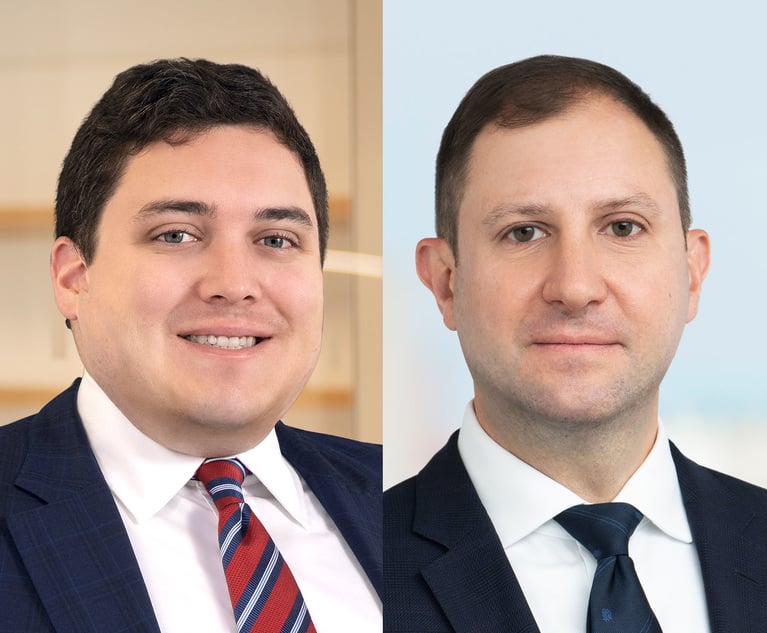Law Firms Are Reimagining Origination Credit
As firms balance client service and talent retention, many are reassessing their credit systems, looking for ways to encourage collaboration while keeping the customer satisfied.
January 03, 2019 at 05:00 PM
12 minute read
The original version of this story was published on The American Lawyer
 Credit: Val Bochkov
Credit: Val Bochkov
Mintz managing member Robert Bodian was out for a run several years ago when he decided to revamp the firm's approach to origination credit.
He worried that the Boston-based firm's policy of awarding all the credit earned from a client to the partner who first brought it to the firm, in perpetuity, established the wrong incentives, even though it was a long-standing practice across the industry.
“That seemed ill-suited for benefiting the firm or the client, because you want more partners taking interest in the client, and you want younger lawyers growing into the client,” he says.
Working on his own—no consultants needed—Bodian started sketching out a replacement plan. He identified goals—fostering teamwork, putting clients first and getting younger attorneys to take more ownership—and began working backward.
 Robert Bodian of Mintz.
Robert Bodian of Mintz.Bodian hit on a system, implemented in 2015, in which no partner gets 100 percent of an origination credit, under any circumstances. The ceiling is set at 75 percent. The remainder is either shared with a colleague who helped bring a client on board or reserved for the firm. And partners who help grow the client relationship can now receive origination credit for new business developed for an existing client.
The cap on credit aims to reinforce a spirit of collaboration and ensure the right attorneys are brought to the client. The credit for new matters from established clients, meanwhile, is intended to benefit rising lawyers, who, as Bodian notes, are less likely to be white men.
“It gives younger, more diverse attorneys more skin in the game and lets them feel that they're involved in growing relationships,” he says.
Mintz is not alone in reassessing its treatment of origination credit. An ALM Intelligence survey recently sent to the Am Law 200 shows that, of 47 respondents, six firms (or 14 percent) revamped their policies during the past five years, while another four firms (or 8.5 percent) are planning on doing so in the next year.
An even larger number of leaders have started rolling the idea around in their heads, Blane Prescott, principal at management consultancy MesaFive, suggests.
“The biggest trend is that firms are increasingly recognizing that it is a problem,” he says, “more than you actually see any action to correct it.”
Firms considering changes to their origination credit schemes must tread carefully. It's “the single most important determinative factor in partner compensation” in law firms, Altman Weil principal Jim Cotterman says. He explains that the metric tracks lawyers' ability to generate a financially profitable book of business that provides work for themselves, their team and others across the firm.
“Without that,” he adds, “there is no firm.”
There are exceptions, but not many. The ALM Intelligence survey found that 83 percent of firms track origination credit. In the vast majority of those that do, according to Bruce MacEwen, president of consultant Adam Smith, Esq., it dwarfs collections, profitability metrics and billable hours in its impact on compensation.
The outliers include those classic lockstep firms, like Cravath, Swaine & Moore and Wachtell, Lipton, Rosen & Katz. Prescott says firms lacking such a system “tend to be the happiest, most successful, most team-oriented firms around.” It's one fewer thing to squabble about. And, freed from worries about holding onto their credits, attorneys can put their clients first and ensure that the most appropriate lawyer gets assigned to a matter.
“Oftentimes, partners will hoard a client so that they can keep the origination, and that may mean doing work that they are not the most qualified to do,” Janet Stanton, MacEwen's colleague at Adam Smith, says.
That's not just bad for the client, it's perilous for the firm.
“As one of the leading law firm malpractice lawyers in the country told us, one of the major sources of malpractice claims is partners practicing out of their core areas of expertise,” MacEwen says.
Origination credit also may incentivize attorneys to bring in clients that might not be the best fit for a firm. All revenue is not created equal.
“If a firm has decided to emphasize and grow certain profit areas and let other practice areas atrophy, it shouldn't be that much of a leap to say, 'You don't get origination credit for bringing in business in the areas we want to get out of,” MacEwen adds.
But the radical step of scrapping origination credit entirely is likely to be a nonstarter, and it might not lead to a desirable outcome anyway. Even the slightest change to how partners get compensated raises the specter that there will be winners and losers. Ripping out the framework entirely will seed even more doubt and anxiety, potentially creating a poisonous environment.
“In large firms, if you don't track the numbers, people will make assumptions about who's contributing that aren't always necessarily right. They can be based more on who's talking loudly about their activities than reality,” Lisa Smith, who heads the Washington, D.C., office of consultant Fairfax Associates, says. “Someone who brought in a big client five years ago might still be talking about it even though they aren't still contributing. I think data is important because it helps balance out the assumptions that people make.”
Bodian faced that challenge when he implemented Mintz's new credit system, after putting it in front of an ad hoc subcommittee for refinement. The decision to cap credit at 75 percent could easily have been a deal-breaker, particularly for senior partners confronted with $8 million in existing credit being trimmed to $6 million with the stroke of a pen. But Bodian sold it as a strategy to increase the size of the pie, in addition to altering the way it gets sliced.
“The trick is to make that $8 million into $10 million by building up the clients more because you have the right incentives in place,” he says. “You have to get buy-in because, on the face of it, it's really disruptive.”
King & Spalding took steps to broaden eligibility for origination credit in a revamp a decade ago, alongside a sunset provision that ensures that all new clients transform to firm clients after three years, according to firm chairman Robert Hays and COO Derek Hardesty. Now, there's no limit to how many partners can claim credit, whether they made the initial client connection, helped land the matter or did the work. As a result, origination credits total three times the actual value of the firm's new client work.
“Firms are trying to encourage their partners to go out and sell as a team,” Cotterman says.
However, there's no consensus about the value in having a sprawling list of names on the origination sheet, like at King & Spalding, where a tally of 15 is not unprecedented.
“In reality, the client doesn't know half of those people,” Prescott says, noting that he's never met a client who said the decision to use a firm was based on more than three people. With more names in the mix, the question is whether the data means anything relative to what the firm is measuring.
“Maybe what you're really doing is measuring something else,” Prescott says. “Maybe you're measuring teamwork.”
Other firms have moved from one metric to two or three out of a desire to track not just how clients get to the firm but why they are staying and who's prompting them to do so. According to Cotterman, that means separately measuring procurement, relationship cultivation and proliferation.
“Multiple categories is better than sharing credits,” argues Smith, who contends that the former approach more effectively recognizes that clients come to a firm in different ways and stay for different reasons.
The duration of origination credit also is up for debate. While King & Spalding installed a three-year sunset provision as part of its revamp, Bodian had the subcommittee at Mintz consider it before concluding that it seemed “a little artificial.” Only eight of the 39 firms in the ALM survey that rely on origination credit reported using a sunset provision.
Stanton and MacEwen caution against awarding credit ad infinitum to the attorney who first drew a client to a firm. Awarding credit on a matter-by-matter basis makes far more sense for incentivizing lawyers, they say.
But Cotterman argues that initial credit, even if passed down from the original recipient, can have a valuable function. He gives the example of a hypothetical client that's been with a firm for 50 years, sticking around long after the partner who brought the client in is gone. Those original credits may continue to flow to a new partner or even a group that's taken over the relationship.
“It's one thing to say, 'We have firm clients,'” Cotterman notes, recognizing that the rhetoric is intended to promote a culture of collaboration. “But, generally, you have somebody that's a point person. The error comes when somebody says, 'You don't have any responsibility. They're a firm client. They've been here too long.'”
If there's no point person, the client is likely being neglected. And if there is one, the lack of credit might prompt that partner to find a firm that would offer handsome compensation for that new client.
“If somebody can walk and take business and your measure of origination is materially different, then what that might suggest is you're probably out of sync with the marketplace,” Cotterman says.
Firms intent on revisiting the subject of origination credit have to determine how complex their rules will be. Of the 39 surveyed firms that track credits, 14 lack any formal rules. That can create tension in the partnership. Imagine a scenario where one junior partner works alongside a senior partner who's eager to share credit, while a second is collaborating with a senior partner who doesn't share at all. In the absence of a stipulated policy on sharing, the first junior partner's stats will look quite different from those of the second, and they will suffer for it come compensation time.
Overly complex systems can backfire, too, Prescott argues, especially when partners lack faith that they will be fairly compensated.
“If you have really good leadership in place and people have a really high level of trust in your compensation results, you can make almost any situation work,” he says. “But often, partners don't have trust and confidence in the results, so they spend more and more time trying to manipulate those results. One of those ways is through origination credits.”
Cotterman, meanwhile, advocates for a methodical process aimed at creating a common set of protocols that reflect the internal realities of any given firm. He suggests that the leaders of the initiative start by laying out a series of vignettes describing specific fact patterns for how clients might arrive at the firm, then introducing variations. Ultimately, the firm should arrive at three to four dozen scenarios. Next, put those fact patterns into a survey and see where partners agree and disagree and follow this with a series of conversations aimed at finding a consensus. From there, leaders can set up a unique set of protocols that reflect the culture and operations of a given firm.
For Cotterman, the exercise is valuable in two ways: It provides resources to help partners resolve uncertainties about the origination process, and it creates a baseline by which to train new partners and potential laterals about the firm's expectations.
“The more you build these protocols and build cohesion, they can be self-administering,” Cotterman says. “Of course, you can have an ombudsman or a mediator, but in a well-functioning system, the partners can take care of it themselves.”
The end goal is an environment in which partners feel comfortable that there's an agreed-upon framework, so they don't feel the need to start arguing about credit allocation before doing anything. It should be “a situation where the offer precedes and exceeds the ask,” as Cotterman puts it.
Although the process employed at Mintz was leaner, Bodian contends the firm has arrived at a comparable outcome: Partners are increasingly working together to grow business. He doesn't think it's a coincidence that profits are up 30 percent over the past three years. But he recognizes that his exact model won't necessarily fit elsewhere.
“Every firm has its own particular set of issues and personalities,” Bodian says.
The results of a failed revamp also should be obvious: any system that continues to incentivize grubbing for credits at the expense of teamwork. Some skeptics think that might be hard to avoid. As Stanton asserts, origination credit fundamentally contributes to the notion of law firms as “hotels for lawyers.”
To stretch the analogy a little further, perhaps firms should aim to develop a formula that encourages partners to spend more time hobnobbing in the lobby and less time sequestered in their rooms.
This content has been archived. It is available through our partners, LexisNexis® and Bloomberg Law.
To view this content, please continue to their sites.
Not a Lexis Subscriber?
Subscribe Now
Not a Bloomberg Law Subscriber?
Subscribe Now
NOT FOR REPRINT
© 2025 ALM Global, LLC, All Rights Reserved. Request academic re-use from www.copyright.com. All other uses, submit a request to [email protected]. For more information visit Asset & Logo Licensing.
You Might Like
View All

Cleary Nabs Public Company Advisory Practice Head From Orrick in San Francisco

The Rise of Female Breadwinners: Challenging Traditional Divorce Dynamics
4 minute read
An Overview of Proposed Changes to the Federal Rules of Procedure Relating to the Expansion of Remote Trial Testimony
15 minute readTrending Stories
Who Got The Work
J. Brugh Lower of Gibbons has entered an appearance for industrial equipment supplier Devco Corporation in a pending trademark infringement lawsuit. The suit, accusing the defendant of selling knock-off Graco products, was filed Dec. 18 in New Jersey District Court by Rivkin Radler on behalf of Graco Inc. and Graco Minnesota. The case, assigned to U.S. District Judge Zahid N. Quraishi, is 3:24-cv-11294, Graco Inc. et al v. Devco Corporation.
Who Got The Work
Rebecca Maller-Stein and Kent A. Yalowitz of Arnold & Porter Kaye Scholer have entered their appearances for Hanaco Venture Capital and its executives, Lior Prosor and David Frankel, in a pending securities lawsuit. The action, filed on Dec. 24 in New York Southern District Court by Zell, Aron & Co. on behalf of Goldeneye Advisors, accuses the defendants of negligently and fraudulently managing the plaintiff's $1 million investment. The case, assigned to U.S. District Judge Vernon S. Broderick, is 1:24-cv-09918, Goldeneye Advisors, LLC v. Hanaco Venture Capital, Ltd. et al.
Who Got The Work
Attorneys from A&O Shearman has stepped in as defense counsel for Toronto-Dominion Bank and other defendants in a pending securities class action. The suit, filed Dec. 11 in New York Southern District Court by Bleichmar Fonti & Auld, accuses the defendants of concealing the bank's 'pervasive' deficiencies in regards to its compliance with the Bank Secrecy Act and the quality of its anti-money laundering controls. The case, assigned to U.S. District Judge Arun Subramanian, is 1:24-cv-09445, Gonzalez v. The Toronto-Dominion Bank et al.
Who Got The Work
Crown Castle International, a Pennsylvania company providing shared communications infrastructure, has turned to Luke D. Wolf of Gordon Rees Scully Mansukhani to fend off a pending breach-of-contract lawsuit. The court action, filed Nov. 25 in Michigan Eastern District Court by Hooper Hathaway PC on behalf of The Town Residences LLC, accuses Crown Castle of failing to transfer approximately $30,000 in utility payments from T-Mobile in breach of a roof-top lease and assignment agreement. The case, assigned to U.S. District Judge Susan K. Declercq, is 2:24-cv-13131, The Town Residences LLC v. T-Mobile US, Inc. et al.
Who Got The Work
Wilfred P. Coronato and Daniel M. Schwartz of McCarter & English have stepped in as defense counsel to Electrolux Home Products Inc. in a pending product liability lawsuit. The court action, filed Nov. 26 in New York Eastern District Court by Poulos Lopiccolo PC and Nagel Rice LLP on behalf of David Stern, alleges that the defendant's refrigerators’ drawers and shelving repeatedly break and fall apart within months after purchase. The case, assigned to U.S. District Judge Joan M. Azrack, is 2:24-cv-08204, Stern v. Electrolux Home Products, Inc.
Featured Firms
Law Offices of Gary Martin Hays & Associates, P.C.
(470) 294-1674
Law Offices of Mark E. Salomone
(857) 444-6468
Smith & Hassler
(713) 739-1250






